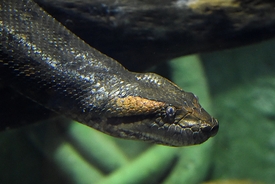I have a recurring dream in which I am accosted by a venomous snake. I make no bones about it: snakes terrify me. Perhaps it's their weird, pin-prick black eyes, possibly it's their horribly slithering, eel-like bodies, or maybe it's the knowledge that many breeds of snake could cause me serious damage with just one bite, or several rib-crushing squeezes from their sickening serpentine frames.
Either way, if there are snakes involved, I'm out. Admittedly snakes have, thus far, been conspicuous in my life only by their absence, unless you count my oft-returning nightmare.
The nightmare started, by the way, when I was sleeping in the living room of a friend's house in New York. Every night, the central heating in the building would come on, issuing a loud 'hissing' noise as it did so. My poor, tortured, sleep-ravaged brain regrettably interpreted this sibilance as dozens of insipid, writhing snakes gliding irresistibly towards me, and thus my interminable nighttime affliction was borne out, never to cease, consistent in its horror.
If there is one place I hope never to visit, then, it is the snake-infested island off the coast of Brazil that is so dangerous, it's actually forbidden for humans to visit.
Ilha da Queimada Grande - otherwise known as Snake Island - might look idyllic from above if one did not know of the fork-tongued horrors that lurk in the rainforests beneath.
Located off the coast of the state of Sao Paolo in the Atlantic Ocean, Snake Island is home to an estimated 4,000 snakes, with some reports suggesting that you would encounter one snake every six yards - concentrated almost exclusively in the island's rainforests.
What's more, the snakes on Ilha da Queimada Grande are among the deadliest - and consequently most terrifying - in the world.
The island is believed to be the only home of the golden lancehead - among the most venomous vipers in the world - which exists on a diet of birds. The golden lancehead is said to have venom up to five times more powerful than its mainland-based relatives, and while local birds are more often than not able to evade capture, birds visiting the island are usually not so fortunate.
So how did this nightmarish locale come to be?
What is now Ilha da Queimada Grande was once attached to mainland Brazil, but rising sea levels separated island from coast roughly 11,000 years ago. Snakes consequently became stranded on the island, and with a lack of ground-based predators, were able to increase their population rapidly.
However, there was also a distinct lack of land-based prey for the snakes to feed on, and so those snakes with the fast-acting toxic venom were the ones who thrived; namely the golden lancehead vipers, who fed on birds. Typically, snakes will stalk their prey before biting it, letting the venom do its work before tracking down the hapless creature again to feed, but the golden lancehead, unable to track its pray in the same way, evolved an incredibly potent venom "capable of killing most prey almost instantly", writes the Smithsonian.
The island is known to almost every Brazilian, though the vast majority will never set foot on it. According to the Smithsonian, the golden lancehead viper's venom can kill a human within an hour, and local legends warn of the grizzly fate of those who happen upon the shores of Snake Island.
As a consequence of its extremely dangerous nature, it is forbidden for members of the public to visit the island - though why anyone would want to is, frankly, beyond me. Even on legally sanctioned visits, the Brazilian government requires a doctor to be present, in case anyone is unfortunate enough to have an encounter with one of the deadly vipers.
Indeed, the only regular visitors are members of the Brazilian navy, who make an annual journey to Ilha da Queimada Grande to maintain the lighthouse that has, since the 1920's, been automated.
Biologists and researchers are also granted special permission to journey to the island to study the golden lancehead vipers.
Rather them than me.

